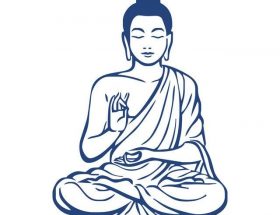After attaining the enlightenment, Gautam Buddha went to the holy city of Benares and shared his new understanding with other fellows who became his disciples immediately. This was considered as the beginning of the Buddhist community. Till his death, Buddha with his band of disciples spread the gospel of the Dhamma among all the classes comprised of beggars, kings and slave girls.
The Basic Teachings of Buddha which are core of Buddhism are-
Buddha’s Teachings
Source of Buddha’s Teachings
The Buddha’s teachings have been reconstructed from stories, found mainly in the Sutta Pitaka. Although some stories describe his miraculous powers, others suggest that the Buddha tried to convince people through reason and persuasion rather than through displays of supernatural power. According to Buddhist philosophy, the world is transient (anicca) and constantly changing; it is also soulless (anatta) as there is nothing permanent or eternal in it. Within this transient world, sorrow (dukkha) is intrinsic to human existence. It is by following the path of moderation between severe penance and self-indulgence that human beings can rise above these worldly troubles. In the earliest forms of Buddhism, whether or not god existed was irrelevant.
Buddhist Teaching of Re-Birth
The Buddha regarded the social world as the creation of humans rather than of divine origin. Therefore, he advised kings and gahapatis to be humane and ethical. Individual effort was expected to transform social relations. The Buddha emphasized individual agency and righteous action as the means to escape from the cycle of rebirth and attain self-realization and nibbana, literally the extinguishing of the ego and desire – and thus end the cycle of suffering for those who renounced the world. According to Buddhist tradition, his last words to his followers were: “Be lamps unto yourselves as all of you must work out your own liberation.”
Buddha’s Teaching – The Way to Salvation
During the course of meditation, Gautam Buddha after attaining the enlightenment came out with the certain principles which have become the pillars of Buddhism. These teachings have also become the guidelines for the followers of Buddha. These principles can broadly be explained under the following categories.
1. The Four Noble Truths
The teachings of Buddha can be summarized under the category of Four Noble Truths which are as under:
a) Suffering is common – Birth, Sickness, Old age, Death etc.
b) Cause of Suffering – ignorance and greed.
c) End of Suffering – to cut off greed and ignorance.
d) Path to end Suffering – the Noble Eightfold Path is the way to end suffering.
2. The Noble Eightfold Path
The teachings of Buddha goes round and round like a great wheel that never stops, leading to the central point of the wheel, the only point which is fixed, Nirvana. The eight spokes on the wheel represent the eight parts of the Noble Eightfold Path which are as follows: 1) Right View; 2) Right Thought; 3) Right Speech; 4) Right Conduct; 5) Right Livelihood; 6) Right Effort; 7) Right Mindfulness; 8) Right Concentration.
The Panchshila
All the religions of the world are based on the fundamental principles of good conduct and prohibit their followers to indulge in the misconduct and misbehavior that may harm the society at large. So, the Panchshila of Buddha is comprised of the basic teachings of conduct which are as under:
1. No killing Respect for life
2. No stealing Respect for others’ property
3. No sexual misconduct Respect for our pure nature
4. No lying Respect for honesty
5. No intoxicants Respect for a clear mind
COURTESY:CULTURE HOLIDAY








